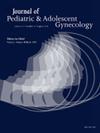Noninvasive Diagnosis of Endometriosis in Adolescents and Young Female Adults: A Systematic Review
IF 1.7
4区 医学
Q3 OBSTETRICS & GYNECOLOGY
引用次数: 0
Abstract
Study Objectives
Our aim was to review the evidence concerning the noninvasive diagnosis of endometriosis in adolescents.
Methods
A systematic review was written following the SWiM reporting guidelines. The study research was made across three databases (MEDLINE/PubMed, Scopus, and Web of Science) to identify articles about the adolescent population and the diagnosis of endometriosis through noninvasive methods. The search included the keywords “endometriosis,” “adolescents,” “diagnosis,” “ultrasound,” and “MRI.” Only English-language articles were considered, and those published prior to 2000 were excluded. The established outcomes focused on clinical symptoms, ultrasound (US), and magnetic resonance imaging (MRI) findings suggestive of endometriosis.
Results
We included 26 articles, mostly comprising case series and cross-sectional studies. The pooled analysis involved 2,299 female adolescents (age range 8-25 years old) with clinically suspected, imaged, and/or surgically confirmed endometriosis. The most frequently reported symptom was dysmenorrhea, followed by chronic pelvic pain. Among adolescents clinically suspected of endometriosis undergoing ultrasound (US), 32.8% exhibited at least one sign of endometriosis. Of the 167 patients with ultrasound-diagnosed endometriosis, 48.5% had deep infiltrating endometriosis (DIE), and 45.5% had an endometrioma detected. Three studies assessed MRI findings, revealing that 49.8% presented with signs of endometriosis.
Conclusions
Dysmenorrhea and chronic pelvic pain stand out as key symptoms of adolescent endometriosis. Although their diagnostic accuracy varies, US and MRI have emerged as valuable tools for diagnosing the disease. While the US may have limitations, especially in detecting subtle lesions, MRI shows promise, even in cases with normal previous ultrasounds. Early recognition and proactive diagnosis are crucial for improving the management of endometriosis in adolescents.
青少年和年轻女性子宫内膜异位症的非侵入性诊断:系统综述。
研究目的我们的目的是回顾有关青少年子宫内膜异位症非侵入性诊断的证据:方法:根据 SWiM 报告指南撰写了一篇系统性综述。该研究通过三个数据库(MEDLINE/PubMed、Scopus 和 Web of Science)进行研究,以确定有关青少年人群和通过非侵入性方法诊断子宫内膜异位症的文章。搜索关键词包括 "子宫内膜异位症"、"青少年"、"诊断"、"超声波 "和 "核磁共振成像"。仅考虑英语文章,并排除了 2000 年以前发表的文章。研究结果主要集中在提示子宫内膜异位症的临床症状、超声波(US)和磁共振成像(MRI)结果:我们共纳入了 26 篇文章,其中大部分是病例系列和横断面研究。汇总分析涉及 2299 名临床怀疑、影像检查和/或手术证实患有子宫内膜异位症的女性青少年(年龄范围为 8-25 岁)。最常见的症状是痛经,其次是慢性盆腔疼痛。在接受超声检查(US)的临床疑似子宫内膜异位症的青少年中,32.8%的人至少表现出一种子宫内膜异位症的症状。在 167 名超声诊断为子宫内膜异位症的患者中,48.5% 患有深部浸润性子宫内膜异位症(DIE),45.5% 患有子宫内膜瘤。三项研究对核磁共振成像结果进行了评估,结果显示49.8%的患者有子宫内膜异位症的迹象:结论:痛经和慢性盆腔疼痛是青少年子宫内膜异位症的主要症状。尽管诊断准确率不一,但 US 和 MRI 已成为诊断该疾病的重要工具。虽然 US 可能存在局限性,尤其是在检测微小病灶方面,但 MRI 却显示出良好的前景,即使是之前超声波检查正常的病例也不例外。早期识别和积极诊断对于改善青少年子宫内膜异位症的治疗至关重要。
本文章由计算机程序翻译,如有差异,请以英文原文为准。
求助全文
约1分钟内获得全文
求助全文
来源期刊
CiteScore
3.90
自引率
11.10%
发文量
251
审稿时长
57 days
期刊介绍:
Journal of Pediatric and Adolescent Gynecology includes all aspects of clinical and basic science research in pediatric and adolescent gynecology. The Journal draws on expertise from a variety of disciplines including pediatrics, obstetrics and gynecology, reproduction and gynecology, reproductive and pediatric endocrinology, genetics, and molecular biology.
The Journal of Pediatric and Adolescent Gynecology features original studies, review articles, book and literature reviews, letters to the editor, and communications in brief. It is an essential resource for the libraries of OB/GYN specialists, as well as pediatricians and primary care physicians.

 求助内容:
求助内容: 应助结果提醒方式:
应助结果提醒方式:


